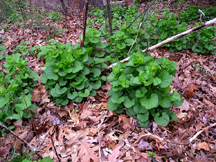Purdue meeting to examine timely, costly issue of invasive species
September 30, 2013
 |
|
Clumps of garlic mustard spread just a few feet from a house in Indiana with a wooded backyard. The plant, native to Europe, was brought to the United States in the 1800s to be cultivated for food and medicinal use. (Purdue Agricultural Communication 2012 photo/Sharon Katz) |
WEST LAFAYETTE, Ind. - Invasive species experts from academia, government, environmental groups and business will gather at Purdue University to develop ways to better detect and control a problem that costs Indiana property owners and taxpayers millions of dollars a year.
The Indiana Invasive Species Early Detection and Rapid Response Conference will be held Oct. 29 from 8 a.m. to 5 p.m. EDT in Room 214 of the Stewart Center.
"This conference is a crucial first step toward establishing a comprehensive early detection and rapid response system in the state to address the growing threat invasive species pose to Indiana's economy, natural resources and citizens," said Steve Yaninek, head of Purdue's entomology department and the university's representative to the Indiana Invasive Species Council.
The Indiana Legislature created the council, which organized the conference, in 2009 to coordinate the state's efforts to address the problem of invasive species.
The conference will cover plants, including weeds; plant pathogens; insects and other invertebrates; terrestrial vertebrates; and fish.
Among speakers are several of the nation's top experts on invasive species, including Mark Renz of the University of Wisconsin, Chuck Bargeron of the University of Georgia and Chris Evans of the Illinois Wildlife Action Plan. Lori Williams, executive director of the National Invasive Species Council, will provide a national perspective on the problem.
One key topic of discussion will be a survey by the Invasive Plant Advisory Committee, which found that Indiana land owners and managers spent $5.85 million last year controlling invasive plants. The committee was created in 2010 to help the Indiana Invasive Species Council work on invasive plant issues in the state.
The committee surveyed 116 agencies, land trusts, municipalities, contractors and private land owners throughout the state, representing more than 650,000 acres of managed public and private land in natural areas such as forests, prairies and wetlands. The survey did not include invasive species control in agricultural fields.
The survey is a good representation of invasive plant management underway in Indiana, said Ellen Jacquart, a committee member and Northern Indiana Stewardship director of The Nature Conservancy, one of the land trusts whose lands have invasive plants.
"The responses demonstrate how invasive species have gotten a strong foothold in Indiana and how expensive it is to remove them," Jacquart said.
Of the groups surveyed, state agencies spent the most on invasive plant management in 2012 - nearly $3 million. Land trusts and municipalities came in second and third, respectively, each group spending slightly more than $1 million.
The survey revealed that Indiana landowners and managers need to control a wide variety of invasive plant species; the survey identified nearly 50 species of invasive plants being managed statewide. More than 73 percent of survey participants reported that they have garlic mustard, making it the most commonly controlled invasive plant in Indiana.
Controlling invasive species is made more difficult because many plant stores in Indiana still sell several species of them.
"More than 95 percent of those surveyed supported removing invasive plants from commercial trade," Jacquart said. "The state is currently exploring a rule that would do just that."
The full report is available on the Indiana Invasive Species Council's website at http://www.entm.purdue.edu/iisc/pdf/Invasive_Plant_Management_Costs_Report.pdf.
The conference is open to the public. More information, including required registration, is at http://www.entm.purdue.edu/iisc/conference.php.
Writer: Keith Robinson, 765-494-2722, robins89@purdue.edu
Sources: Steve Yaninek, 765-494-4554, yaninek@purdue.edu
Ellen Jacquart, 317-829-3814, ejacquart@tnc.org
Related website:
Purdue Department of Entomology
Ag Communications: (765) 494-2722;
Keith Robinson, robins89@purdue.edu
Agriculture News Page

